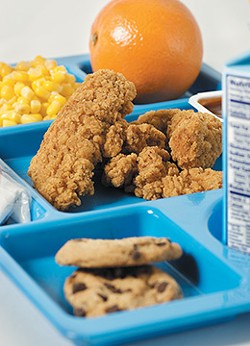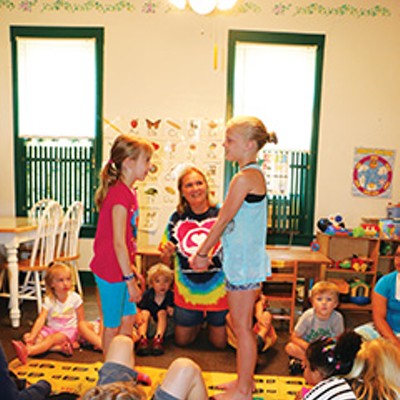What’s for lunch at school?
District 186 cafeterias are trying, but kids are still complaining
[
{
"name": "Air - MedRect Combo - Inline Content 1",
"component": "11490391",
"insertPoint": "3",
"requiredCountToDisplay": "1",
"parentWrapperClass": "fdn-ads-inline-content-block"
},{
"name": "Air - MedRect Combo - Inline Content 2",
"component": "11490392",
"insertPoint": "7",
"requiredCountToDisplay": "5",
"parentWrapperClass": "fdn-ads-inline-content-block"
},{
"name": "Air - MedRect Combo - Inline Content 3",
"component": "11490393",
"insertPoint": "12",
"requiredCountToDisplay": "9",
"parentWrapperClass": "fdn-ads-inline-content-block"
}
]
Cordelia Marlow, an eighth-grader at Franklin Middle School, describes her school lunches as poor. “The food quality went down after 2010,” she said, referring to changes in the federally funded National School Lunch program. “The taste and texture are bad. The meat is soggy and tastes kind of weird.”
The National School Lunch program provides lunches to nearly 32 million children. The new standards implemented after the passage of the Healthy, Hunger-Free Kids Act of 2010 are an effort to curb childhood obesity and reduce hunger through healthier meal options.
Jan Miller, food service director for Springfield Public Schools District 186, follows strict guidelines when planning menus. She estimates she feeds 11,000 children across 32 schools on a daily basis. Under the guidelines, each meal must contain a fruit, vegetable, milk, protein and whole grain and meet caloric, sodium and fat specifications.
Cordelia said students don’t get enough to eat. “It’s not enough to keep you going,” she said. “If you don’t eat breakfast, it’s definitely not enough.”
Her father, Scott Marlow, concurs. “She’s an active kid,” he said, adding menus should be tailored to individual needs. “A growing athlete needs twice the amount of calories.”
“She often comes home extremely hungry,” said her mother, Lara Marlow. “My kid is in sports and often walks home. She will be so hungry that she will eat an entire packet of granola bars, drink several glasses of milk or juice or eat an entire packet of fruit snacks.”
The rules are complicated and the school district has hired a dietician. “There’s very little wiggle room,” said Miller, and added schools have dropped out of the program. “It’s ridiculous. We just want to feed kids.
“We knew this was coming,” she continued. She began introducing fresh fruits and vegetables, whole grains and reduced fat items as early as 2008. “It’s been a struggle.” Children aren’t used to eating this way at home. The biggest challenge has been introducing whole grains.
Children must have one fruit and vegetable at every meal. The district recently introduced salad bars in the middle and high schools and plans to introduce them in the elementary schools. “Kids like it,” said Miller. The salad bars offer a wide variety of fruit and vegetable options.
Each child must take at least three items for the school district to be reimbursed by the federal government for that meal, which comes to $3 per child for lunch and $1.80 per child for breakfast. “It doesn’t mean they’ll eat it,” said Miller, who has seen a lot of waste. “Some children will take it and walk over to the garbage.”
Cordelia concurs. “One-third of the kids will throw it away,” she said. “You can’t say you’re not hungry and just grab an apple. You have to get an entrée and a side.”
Her friends usually skip lunch. “My friend Kayli said it makes her nauseous,” said Cordelia. A typical lunch might consist of a chicken patty on a bun, fruit cup, a side like potato wedges and milk.
“They cut out all the fried food and desserts,” said Cordelia, adding the food would taste better if it were organic and it wasn’t soggy. Her favorite lunch item is the potato wedges. “They’re crispy,” she said. “They taste like potatoes.”
Cordelia eats fairly healthy at home. “I don’t eat McDonald’s,” she said, though she does have an occasional cookie. “I like cookies.” Her mom and dad cook 90 percent of the meals.
“The kids eating better are the younger ones,” said Miller, who had one parent call and complain that their child was being forced to take a fruit and vegetable and said the school couldn’t force them to eat it. For the most part, parents have expressed a lot of interest and want to see the district offering healthier foods.
The district accommodates special diets. “We work with parents,” said Miller. The parents will generally contact the school nurse if their child has special dietary needs and the nurse will contact her or one of her staff. “We make sure there is a meal available for them,” she said.
“We have a lot of hungry kids,” said Miller, adding that for a lot of children this is their only meal. It’s an opportunity to introduce young children to healthy eating.
The district recently received a fruit and vegetable grant for its elementary schools. Under the program, children are introduced to a new fruit or vegetable and learn about it. “It’s one of the few good programs that the USDA put together,” said Miller.
The district is moving towards cooking from scratch meals and away from processed foods. This summer managers are attending classes at Lincoln Land Community College through a grant and learning basic cooking skills from local chefs. “Cooking is a lost art,” said Miller.
Wes King, executive director of the Illinois Stewardship Alliance, said the first step towards implementing the Farm to School program is “from scratch” cooking. The program connects communities and local farmers and provides fresh, healthy food to schools and educational opportunities.
“Students learn where their food comes from,” said King, adding they’re more likely to eat it if they know how it’s grown. He praised Jay Ayers, food service director at New Berlin, for the work he has done implementing the program there. “He has made it work.”
Farmers want to become involved; however, the infrastructure isn’t in place. Schools can’t drive to each farm. With food grown locally, there is a short supply chain. Food can be harvested and transported to schools within one to two days. “It’s fresh and more nutritious,” said King.
Famers have to work together. “It’s going to take a small farmer or entrepreneur to step up and take the risk,” said King. “We’re moving in the right direction.”
According to the most recent Farm to School Census figures released in 2012, 164 Illinois school districts participated in the program; nationwide, 4,322 districts participated.
While District 186 doesn’t participate, it is taking steps in that direction. “We’re a big district,” said Miller, adding there aren’t enough local farmers to accommodate the district’s needs. “We purchase local as much as possible.
“We are always trying to improve,” added Miller.
Roberta Codemo of Springfield is a freelance journalist and is a frequent contributor to Illinois Times.
The National School Lunch program provides lunches to nearly 32 million children. The new standards implemented after the passage of the Healthy, Hunger-Free Kids Act of 2010 are an effort to curb childhood obesity and reduce hunger through healthier meal options.
Jan Miller, food service director for Springfield Public Schools District 186, follows strict guidelines when planning menus. She estimates she feeds 11,000 children across 32 schools on a daily basis. Under the guidelines, each meal must contain a fruit, vegetable, milk, protein and whole grain and meet caloric, sodium and fat specifications.
Cordelia said students don’t get enough to eat. “It’s not enough to keep you going,” she said. “If you don’t eat breakfast, it’s definitely not enough.”
Her father, Scott Marlow, concurs. “She’s an active kid,” he said, adding menus should be tailored to individual needs. “A growing athlete needs twice the amount of calories.”
“She often comes home extremely hungry,” said her mother, Lara Marlow. “My kid is in sports and often walks home. She will be so hungry that she will eat an entire packet of granola bars, drink several glasses of milk or juice or eat an entire packet of fruit snacks.”
The rules are complicated and the school district has hired a dietician. “There’s very little wiggle room,” said Miller, and added schools have dropped out of the program. “It’s ridiculous. We just want to feed kids.
“We knew this was coming,” she continued. She began introducing fresh fruits and vegetables, whole grains and reduced fat items as early as 2008. “It’s been a struggle.” Children aren’t used to eating this way at home. The biggest challenge has been introducing whole grains.
Children must have one fruit and vegetable at every meal. The district recently introduced salad bars in the middle and high schools and plans to introduce them in the elementary schools. “Kids like it,” said Miller. The salad bars offer a wide variety of fruit and vegetable options.
Each child must take at least three items for the school district to be reimbursed by the federal government for that meal, which comes to $3 per child for lunch and $1.80 per child for breakfast. “It doesn’t mean they’ll eat it,” said Miller, who has seen a lot of waste. “Some children will take it and walk over to the garbage.”
Cordelia concurs. “One-third of the kids will throw it away,” she said. “You can’t say you’re not hungry and just grab an apple. You have to get an entrée and a side.”
Her friends usually skip lunch. “My friend Kayli said it makes her nauseous,” said Cordelia. A typical lunch might consist of a chicken patty on a bun, fruit cup, a side like potato wedges and milk.
“They cut out all the fried food and desserts,” said Cordelia, adding the food would taste better if it were organic and it wasn’t soggy. Her favorite lunch item is the potato wedges. “They’re crispy,” she said. “They taste like potatoes.”
Cordelia eats fairly healthy at home. “I don’t eat McDonald’s,” she said, though she does have an occasional cookie. “I like cookies.” Her mom and dad cook 90 percent of the meals.
“The kids eating better are the younger ones,” said Miller, who had one parent call and complain that their child was being forced to take a fruit and vegetable and said the school couldn’t force them to eat it. For the most part, parents have expressed a lot of interest and want to see the district offering healthier foods.
The district accommodates special diets. “We work with parents,” said Miller. The parents will generally contact the school nurse if their child has special dietary needs and the nurse will contact her or one of her staff. “We make sure there is a meal available for them,” she said.
“We have a lot of hungry kids,” said Miller, adding that for a lot of children this is their only meal. It’s an opportunity to introduce young children to healthy eating.
The district recently received a fruit and vegetable grant for its elementary schools. Under the program, children are introduced to a new fruit or vegetable and learn about it. “It’s one of the few good programs that the USDA put together,” said Miller.
The district is moving towards cooking from scratch meals and away from processed foods. This summer managers are attending classes at Lincoln Land Community College through a grant and learning basic cooking skills from local chefs. “Cooking is a lost art,” said Miller.
Wes King, executive director of the Illinois Stewardship Alliance, said the first step towards implementing the Farm to School program is “from scratch” cooking. The program connects communities and local farmers and provides fresh, healthy food to schools and educational opportunities.
“Students learn where their food comes from,” said King, adding they’re more likely to eat it if they know how it’s grown. He praised Jay Ayers, food service director at New Berlin, for the work he has done implementing the program there. “He has made it work.”
Farmers want to become involved; however, the infrastructure isn’t in place. Schools can’t drive to each farm. With food grown locally, there is a short supply chain. Food can be harvested and transported to schools within one to two days. “It’s fresh and more nutritious,” said King.
Famers have to work together. “It’s going to take a small farmer or entrepreneur to step up and take the risk,” said King. “We’re moving in the right direction.”
According to the most recent Farm to School Census figures released in 2012, 164 Illinois school districts participated in the program; nationwide, 4,322 districts participated.
While District 186 doesn’t participate, it is taking steps in that direction. “We’re a big district,” said Miller, adding there aren’t enough local farmers to accommodate the district’s needs. “We purchase local as much as possible.
“We are always trying to improve,” added Miller.
Roberta Codemo of Springfield is a freelance journalist and is a frequent contributor to Illinois Times.
Illinois Times has provided readers with independent journalism for almost 50 years, from news and politics to arts and culture.
Your support will help cover the costs of editorial content published each week. Without local news organizations, we would be less informed about the issues that affect our community..
Got something to say?
Send a letter to the editor and we'll publish your feedback in print!



















